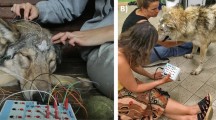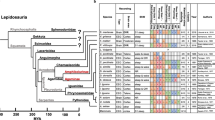Abstract
All terrestrial mammals studied so far do maximal amounts of sleeping at birth, with sleep time gradually decreasing to adult levels. This has led to the concept that sleep, with its characteristic immobility and unresponsiveness, is necessary for brain and body development. We reported1 that dolphins and killer whales have a very unusual developmental pattern: neonates are maximally and continuously active at birth, and this activity diminishes over a period of months to the adult level; in the postpartum period, mothers also abruptly cease the characteristic ‘hanging’ that constitutes the typical sleep behaviour in bottlenose dolphins and killer whales2,3,4,5. We did not claim that all sleep was abolished in the postpartum period. Rather, we reported that immobility was absent and that typical sleep posture increases with age, a pattern opposite to that seen in all land mammals studied so far. Sekiguchi et al.6 and Gnone et al.7 challenge our conclusions.
Similar content being viewed by others
Main
Figure 1 of Sekiguchi et al.6 shows that maternal eye closure at the surface increases with age, which is consistent with our findings. Like us, they find that swimming is well coordinated, that neither neonate nor mother collide with the other animals, that animals vocalize during swimming, and that there is no hanging behaviour in the immediate postnatal period. We have serious reservations about their behavioural and eye-closure data because of the very small number of observations, the making of observations only when the animals approached a single underwater observation window, and the observations of eyelids only during the day rather than during the normal nocturnal sleep period (which also applies to the observations made by Gnone et al.7). By contrast, we monitored the animals' behaviour continuously and recorded the state of both eyes during both day and night.
Gnone et al.7 conclude from their findings that the observed behavioural pattern “resembles [the sleep attitude] of (diurnal) terrestrial mammals, including humans”. However, this claim is contradicted not only by our results1 and by those of Sekiguchi et al.6, but is also inconsistent with their own data: they report an absence of hanging behaviour in the neonate and mother, with this behaviour not appearing in the neonate until 12 weeks of age and then increasing until one year of age; they also claim that alert swimming is maximal at birth and decreases with age. Both of these observations7 agree with our earlier findings1.
This claim of Gnone et al.7 also ignores research documenting dolphins' unihemispheric slow waves, avoidance of obstacles while in motion for 24 hours a day, and likely absence of sleep characterized by rapid eye movement (REM)8. However, we completely agree with the conclusion of Sekiguchi et al.6 that cetacean sleep differs profoundly from that of terrestrial mammals.
One might try to draw an analogy between the neonates' continuous activity and sleep walking. However, sleep walking is a pathological, episodic state, in which coordination is grossly impaired and injuries frequently occur; it has not been established that sleep walking effectively substitutes for normal sleep, and it is interspersed with normal sleep episodes. In contrast, the postpartum swimming of dolphins and killer whales is characterized by precise course adjustments and vocalizations as the animals circumnavigate the irregular dimensions of the pools1. Neonates surface to breathe at 10–40-second intervals, keeping both eyes open, as also described by Sekiguchi et al.6; such open eyes are an indicator of electroencephalogram-defined wakefulness5. After each breath, the neonate locates, pursues and catches up with the mother, who breathes less frequently. It seems reasonable to us to state that typical sleep behaviour as seen in adult cetaceans and land mammals4,5 is greatly reduced in dolphins and killer whales in the postpartum period8, and that sustained periods of sleep lasting 10–40 seconds do not occur. Such interrupted sleep does not fulfil sleep's function in land mammals1,8.
Whatever terminology is used, it is clear that the sensorimotor coordination seen in postnatal dolphins and killer whales not only involves extensive muscular activation, but also necessitates widespread activation of the brainstem9,10,11 and most likely of forebrain neurons — in contrast with the neuronal activity pattern seen in the sleep of terrestrial mammals12. This difference in postpartum behaviour and neural function between cetaceans and terrestrial mammals has important implications for theories of sleep function and particularly for theories of the role of sleep in development8.
References
Lyamin, O., Pryaslova, J., Lance, V. & Siegel, J. Nature 435, 1177 (2005).
Flanigan, W. F. Sleep Res. 3, 84 (1974).
Flanigan, W. F. Sleep Res. 4, 139 (1975).
Lyamin, O. I. et al. Behav. Brain Res. 129, 125–129 (2002).
Lyamin, O. I., Mukhametov, L. M. & Siegel, J. M. Arch. Ital. Biol. 142, 557–568 (2004).
Sekiguchi, Y., Arai, K. & Kohshima, S. Nature 441, doi:10.1038/nature04898 (2006).
Gnone, G., Moriconi, T. & Gambini, G. Nature 441, doi:10.1038/nature04899 (2006).
Siegel, J. M. Nature 437, 1264–1271 (2005).
Siegel, J. M. & McGinty, D. J. Science 196, 678–680 (1977).
Siegel, J. M. Brain Res. Rev. 1, 69–105 (1979).
Siegel, J. M. & Tomaszewski, K. S. J. Neurophysiol. 50, 696–716 (1983).
Siegel, J. M. in Principles and Practice of Sleep Medicine (eds Kryger, M. H., Roth, T. & Dement, W. C.) 120–135 (Elsevier Saunders, Philadelphia, 2005).
Author information
Authors and Affiliations
Corresponding author
Rights and permissions
About this article
Cite this article
Lyamin, O., Pryaslova, J., Lance, V. et al. Sleep in continuously active dolphins; Activity and sleep in dolphins (Reply). Nature 441, E11 (2006). https://doi.org/10.1038/nature04900
Published:
Issue Date:
DOI: https://doi.org/10.1038/nature04900
This article is cited by
-
Float, explode or sink: postmortem fate of lung-breathing marine vertebrates
Palaeobiodiversity and Palaeoenvironments (2012)
Comments
By submitting a comment you agree to abide by our Terms and Community Guidelines. If you find something abusive or that does not comply with our terms or guidelines please flag it as inappropriate.



